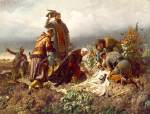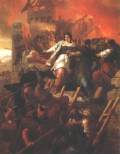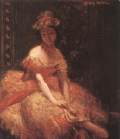

Bertalan Székely, one of the most significant artists, was fighting with problems all his life. He came from a noble family in Kolozsvár.
After years of working as a wandering painter in Transylvania, he went to Munich where he painted his Self-Portrait in 1860. This was the first self-portrait full of romantic passions and self-confidence in Hungarian painting, although his style was old-fashioned, and dynamic freedom of his brushwork appeared only at the end of his life. He painted Discovery of the Body of King Louis the Second, his best known picture, around 1860. It had been painted several times previously as the subject had a symbolic message. Careful composition, pathetic drama and character portrayal make Székely's picture exceed conventional historic pictures. Dobozy and His Wife (1861) has a particularly dramatic tension owing to its dramatic composition and effective contours.
 He returned to Pest in 1864 and stayed there for the rest of his life. He finished Women of Eger in 1867 for which he had prepared a number of interesting and carefully drawn sketches and details. However, the final version lacks the persuasive power due to exagerations. One of the best pictures of the historical genre was King László V and Ulrik Czillei showing an interior with low horizon. The stifling atmosphere and the distant look of the young king unsuspicious of what is going to happen are in sharp contrast with the gestures of dancers and the profile of Czillei, a devilish seducer. Farewell of Thököly dates from the year 1875 as if a cadenza to the persisting ideal of the war of independence. From 1880 onwards, he was engaged in monumental frescoes. With his large scale compositions for the Budapest Opera House, the Cathedral in Pécs and the Town Hall in Kecskemét (Contract Sealed witn Blood, 1896-97), he broke with grave forms of previous times, his composition became less formal and colours more delicate, there are fewer details carefully worked out for which Contract Sealed with Blood is the best example. The last station of his artistic development is represented by frescoes for Vajdahunyad Castle which he never finished, and which in fact preceded Art Nouveau.
He returned to Pest in 1864 and stayed there for the rest of his life. He finished Women of Eger in 1867 for which he had prepared a number of interesting and carefully drawn sketches and details. However, the final version lacks the persuasive power due to exagerations. One of the best pictures of the historical genre was King László V and Ulrik Czillei showing an interior with low horizon. The stifling atmosphere and the distant look of the young king unsuspicious of what is going to happen are in sharp contrast with the gestures of dancers and the profile of Czillei, a devilish seducer. Farewell of Thököly dates from the year 1875 as if a cadenza to the persisting ideal of the war of independence. From 1880 onwards, he was engaged in monumental frescoes. With his large scale compositions for the Budapest Opera House, the Cathedral in Pécs and the Town Hall in Kecskemét (Contract Sealed witn Blood, 1896-97), he broke with grave forms of previous times, his composition became less formal and colours more delicate, there are fewer details carefully worked out for which Contract Sealed with Blood is the best example. The last station of his artistic development is represented by frescoes for Vajdahunyad Castle which he never finished, and which in fact preceded Art Nouveau.
 Besides monumental works, Székely painted landscapes and portraits, genre pictures and illustrations. In the last period of his life, his art became relieved from grave colours of the academy, his brushwork lighter and colours airy. Compositions became more natural and free of pathos, e.g. Dancer, or Boy with Bread and Butter, two bright pictures where the natural light and sunshine are particularly fascinating.
Besides monumental works, Székely painted landscapes and portraits, genre pictures and illustrations. In the last period of his life, his art became relieved from grave colours of the academy, his brushwork lighter and colours airy. Compositions became more natural and free of pathos, e.g. Dancer, or Boy with Bread and Butter, two bright pictures where the natural light and sunshine are particularly fascinating.